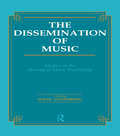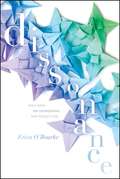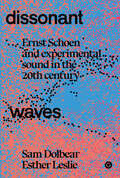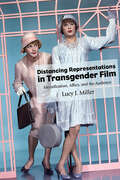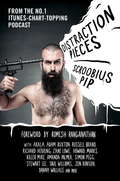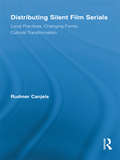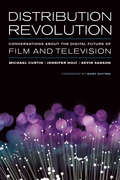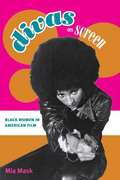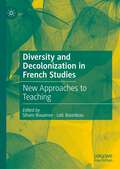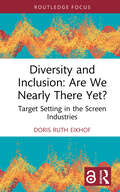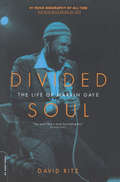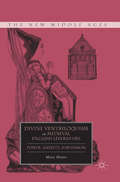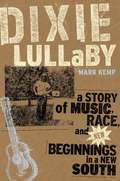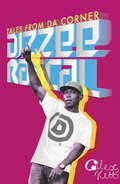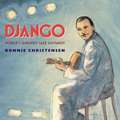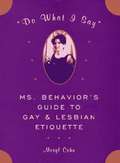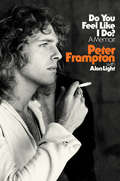- Table View
- List View
Displacements: Reading Space and Time in Moving Image Installations (Palgrave Close Readings in Film and Television)
by Alison ButlerThis book is about the aesthetics and politics of contemporary artists’ moving image installations, and the ways that they use temporal and spatial relationships in the gallery to connect with geopolitical issues. Displaced from the cinema, moving images increasingly address themes of movement and change in the world today. Digital technology has facilitated an explosion of work of this kind, and the expansion of contemporary art museums, biennales and large-scale exhibitions all over the world has created venues and audiences for it. Despite its 20th century precursors, this is a new and distinct artistic form, with an emerging body of thematic concerns and aesthetics strategies. Through detailed analysis of a range of important 21st century works, the book explores how this spatio-temporal form has been used to address major issues of our time, including post-colonialism, migration and conflict. Paying close attention to the ways in which moving images interact with the specific spaces and sites of exhibition, the book explores the mobile viewer’s experiences in these immersive and transitory works.
Disrupting the Game: From the Bronx to the Top of Nintendo
by Reggie Fils-AiméReggie Fils-Aimé, retired President and Chief Operating Officer of Nintendo of America Inc., shares leadership lessons and inspiring stories from his unlikely rise to the top. Although he&’s best known as Nintendo's iconic President of the Americas-immortalized for opening Nintendo&’s 2004 E3 presentation with, &“My name is Reggie, I'm about kicking ass, I'm about taking names, and we're about making games&”-Reggie Fils-Aimé&’s story is the ultimate gameplan for anyone looking to beat the odds and achieve success.Learn from Reggie how to leverage disruptive thinking to pinpoint the life choices that will make you truly happy, conquer negative perceptions from those who underestimate or outright dismiss you, and master the grit, perseverance, and resilience it takes to dominate in the business world and to reach your professional dreams.As close to sitting one-on-one with the gaming legend as it gets, you will learn:About the challenges Reggie faced throughout his life and career-from his humble childhood as the son of Haitian immigrants, to becoming one of the most powerful names in the history of the gaming industry.What it takes to reach the top of your own industry, including being brave enough to stand up for your ideas, while also being open to alternative paths to success.How to create vibrant and believable visions for your team and company.How to maintain relentless curiosity and know when to ask questions to shatter the status quo.
Dissemination of Music: Studies in the History of Music Publishing (Musicology #14)
by Hans LennebergFirst Published in 1995. Routledge is an imprint of Taylor & Francis, an informa company.
Dissonance
by Erica O'RourkeIn this inventive romantic thriller, Del has the power to navigate between alternate realities—and the power to save multiple worlds.<P> Delancey knows for sure that there is more than one universe. Many more. Because every time someone makes a choice, a new, parallel world is spun off the existing one. Eating breakfast or skipping it, turning left instead of right, sneaking out instead of staying in bed—all of these choices create alternate universes in which echo selves take the roads not traveled. Del knows all of this because she’s a Walker, someone who can navigate between the worlds, and whose job is to keep the dimensions in harmony.<P> But Del’s decisions have consequences too. Even though she’s forbidden from Walking after a training session goes horribly wrong, she secretly starts to investigate other dissonant worlds. She’s particularly intrigued by the echo versions of Simon Lane, a guy who won’t give her the time of day in the main world, but whose alternate selves are uniquely interested. But falling for Simon draws Del closer to a truth that the Council of Walkers is trying to hide—a secret that threatens the fate of the entire multiverse.
Dissonance
by Erica O'RourkeIn this inventive romantic thriller, Del has the power to navigate between alternate realities--and the power to save multiple worlds.Every time someone makes a choice, a new, parallel world is spun off the existing one. Eating breakfast or skipping it, turning left instead of right, sneaking out instead of staying in bed--all of these choices create alternate universes in which echo selves take the roads not traveled. Del knows this because she's a Walker, someone who can navigate between the worlds, and whose job is to keep the dimensions in harmony.But Del's decisions have consequences too. Even though she's forbidden from Walking after a training session goes horribly wrong, she secretly starts to investigate other dissonant worlds. She's particularly intrigued by the echo versions of Simon Lane, a guy who won't give her the time of day in the main world, but whose alternate selves are uniquely interested. But falling for Simon draws Del closer to a truth that the Council of Walkers is trying to hide--a secret that threatens the fate of the entire multiverse."O'Rourke brilliantly builds an intricate and complex alternate science-fiction universe that contains beautiful imagery and visualization. A definite page-turner." --School Library Journal
Dissonant Waves: Ernst Schoen and Experimental Sound in the 20th century (Goldsmiths Press / Sonics Series)
by Esther Leslie Sam DolbearAn investigation of the cultures and technologies of early radio and how a generation of cultural operators—with Schoen at the center—addressed crisis and adversity.Dials, knobs, microphones, clocks; heads, hands, breath, voices. Ernst Schoen joined Frankfurt Radio in the 1920s as programmer and accelerated the potentials of this collision of bodies and technologies. As with others of his generation, Schoen experienced crisis after crisis, from the violence of war, the suicide of friends, economic collapse, and a brief episode of permitted experimentalism under the Weimar Republic for those who would foster aesthetic, technical, and political revolution. The counterreaction was Nazism—and Schoen and his milieux fell victim to it, found ways out of it, or hit against it with all their might.Dissonant Waves tracks the life of Ernst Schoen—poet, composer, radio programmer, theorist, and best friend of Walter Benjamin from childhood—as he moves between Frankfurt, Berlin, Paris, and London. It casts radio history and practice into concrete spaces, into networks of friends and institutions, into political exigencies and domestic plights, and into broader aesthetic discussions of the politicization of art and the aestheticization of politics. Through friendship and comradeship, a position in state-backed radio, imprisonment, exile, networking in a new country, re-emigration, ill-treatment, neglect, Schoen suffers the century and articulates its broken promises.An exploration of the ripples of radio waves, the circuits of experimentation and friendship, and the proposals that half-found a route into the world—and might yet spark political-technical experimentation.
Distance, Theatre, and the Public Voice, 1750–1850
by M. NussAs theatres expanded in the eighteenth and nineteenth centuries, the distance between actor and audience became a telling metaphor for the distance emerging between writers and readers. Nuss explores the ways in which theatre helped authors imagine connecting with a new mass audience.
Distancing Representations in Transgender Film: Identification, Affect, and the Audience (SUNY series, Horizons of Cinema)
by Lucy J. MillerDistancing Representations in Transgender Film explores the representation of transgender identity in several important cinema genres: comedies, horror films, suspense thrillers, and dramas. In a critique that is both deeply personal and theoretically sophisticated, Lucy J. Miller examines how these representations are often narratively and visually constructed to prompt emotions of ridicule, fear, disgust, and sympathy from a cisgender audience. Created by and for cisgender people, these films do not accurately represent transgender people's experiences, and the emotions they inspire serve to distance cisgender audience members from the transgender people they encounter in their day-to-day lives. By helping to increase the distance between cisgender and transgender people, Miller argues, these films make it more difficult for cisgender people to understand the experiences of transgender people and for transgender people to fully participate in public life. The book concludes with suggestions for improving transgender representation in film.
Distraction Pieces
by Scroobius PipJoin Scroobius Pip as he gets to the bottom of what matters most in life: whether getting Russell Brand to expound on capitalism, Jon Ronson on the perils of social media, Simon Pegg on the power of satire, Killer Mike on race relations in the United States or Howard Marks on drugs and cancer, Pip elicits thought-provoking material by rummaging through the minds of some of the most interesting creatives of our time. Distraction Pieces features both curated highlights from the iTunes-chart-topping podcast - from Akala to Howard Marks via the likes of Adam Buxton, Romesh Ranganathan and Amanda Palmer - and exclusive new content, with chapters on politics, social media, music, comedy and more. Featuring illustrations by tattoo artist mr heggie, this is a must-have for fans of the Distraction Pieces podcast, and a must-read for anyone interested in the creative mind.
Distraction Pieces
by Scroobius PipThe Times Bestseller (Non-Fiction)Join Scroobius Pip as he gets to the bottom of what matters most in life: whether getting Russell Brand to expound on capitalism, Jon Ronson on the perils of social media, Simon Pegg on the power of satire, Killer Mike on race relations in the United States or Howard Marks on drugs and cancer, Pip elicits thought-provoking material by rummaging through the minds of some of the most interesting creatives of our time. Distraction Pieces features both curated highlights from the iTunes-chart-topping podcast - from Akala to Howard Marks via the likes of Adam Buxton, Romesh Ranganathan and Amanda Palmer - and exclusive new content, with chapters on politics, social media, music, comedy and more. Featuring illustrations by tattoo artist mr heggie, this is a must-have for fans of the Distraction Pieces podcast, and a must-read for anyone interested in the creative mind.
Distraction Pieces
by Scroobius PipThe Times Bestseller (Non-Fiction)Join Scroobius Pip as he gets to the bottom of what matters most in life: whether getting Russell Brand to expound on capitalism, Jon Ronson on the perils of social media, Simon Pegg on the power of satire, Killer Mike on race relations in the United States or Howard Marks on drugs and cancer, Pip elicits thought-provoking material by rummaging through the minds of some of the most interesting creatives of our time. Distraction Pieces features both curated highlights from the iTunes-chart-topping podcast - from Akala to Howard Marks via the likes of Adam Buxton, Romesh Ranganathan and Amanda Palmer - and exclusive new content, with chapters on politics, social media, music, comedy and more. Featuring illustrations by tattoo artist mr heggie, this is a must-have for fans of the Distraction Pieces podcast, and a must-read for anyone interested in the creative mind.
Distributing Silent Film Serials: Local Practices, Changing Forms, Cultural Transformation (Routledge Advances in Film Studies)
by Rudmer CanjelsTracing the international consumption, distribution, and cultural importance of silent film serials in the 1910s and 1920s, Canjels provides an exciting new understanding of the cultural dimension and the cultural transformation and circulation of media forms. Specifically, he demonstrates that the serial film form goes far beyond the well-known American two-reel serial—the cliffhanger. Throughout the book, Canjels focuses on the biggest producers of serials, America, France, and Germany, while imported serials, such as those in the Netherlands, are also examined. This research offers new views on the serial work of well known directors as D.W. Griffith, Abel Gance, Erich von Stroheim, and Fritz Lang, while foregrounding the importance of lesser known directors such as Louis Feuillade or Joe May. In the early twentieth-century, serial productions were constantly undergoing change and were not merely distributed in their original form upon import. As adjusted serials were present in large quantities or confronted different social spaces, nationalistic feelings and views stimulated by the unrest of World War I and the expanding American film industry could be incorporated and attached to the serial form. Serial productions were not only adaptable to local discourses, they could actively stimulate and interact as well, influencing reception and further film production. By examining the distribution, reception, and cultural contexts of American and European serials in various countries, this cross-cultural research makes both local and global observations. Canjels thus offers a highly relevant case study of transnational, transcultural and transmedia relations.
Distribution Revolution
by Jennifer Holt Kevin Sanson Michael CurtinDistribution Revolution is a collection of interviews with leading film and TV professionals concerning the many ways that digital delivery systems are transforming the entertainment business. These interviews provide lively insider accounts from studio executives, distribution professionals, and creative talent of the tumultuous transformation of film and TV in the digital era. The first section features interviews with top executives at major Hollywood studios, providing a window into the big-picture concerns of media conglomerates with respect to changing business models, revenue streams, and audience behaviors. The second focuses on innovative enterprises that are providing path-breaking models for new modes of content creation, curation, and distribution--creatively meshing the strategies and practices of Hollywood and Silicon Valley. And the final section offers insights from creative talent whose professional practices, compensation, and everyday working conditions have been transformed over the past ten years. Taken together, these interviews demonstrate that virtually every aspect of the film and television businesses is being affected by the digital distribution revolution, a revolution that has likely just begun. Interviewees include: * Gary Newman, Chairman, 20th Century Fox Television * Kelly Summers, Former Vice President, Global Business Development and New Media Strategy, Walt Disney Studios * Thomas Gewecke, Chief Digital Officer and Executive Vice President, Strategy and Business Development, Warner Bros. Entertainment * Ted Sarandos, Chief Content Officer, Netflix * Felicia D. Henderson, Writer-Producer, Soul Food, Gossip Girl * Dick Wolf, Executive Producer and Creator, Law & Order
Divas on Screen: Black Women in American Film
by Mia MaskThis insightful study places African American women's stardom in historical and industrial contexts by examining the star personae of five African American women: Dorothy Dandridge, Pam Grier, Whoopi Goldberg, Oprah Winfrey, and Halle Berry. Interpreting each woman's celebrity as predicated on a brand of charismatic authority, Mia Mask shows how these female stars have ultimately complicated the conventional discursive practices through which blackness and womanhood have been represented in commercial cinema, independent film, and network television. Mask examines the function of these stars in seminal yet underanalyzed films. She considers Dandridge's status as a sexual commodity in films such as Tamango, revealing the contradictory discourses regarding race and sexuality in segregation-era American culture. Grier's feminist-camp performances in sexploitation pictures Women in Cages and The Big Doll House and her subsequent blaxploitation vehicles Coffy and Foxy Brown highlight a similar tension between representing African American women as both objectified stereotypes and powerful, self-defining icons. Mask reads Goldberg's transforming habits in Sister Act and The Associate as representative of her unruly comedic routines, while Winfrey's daily television performance as self-made, self-help guru echoes Horatio Alger narratives of success. Finally, Mask analyzes Berry's meteoric success by acknowledging the ways in which Dandridge's career made Berry's possible.
Diversions: 50 Comic Short Stories
by Richard Markgraf50 comic pieces by the author which will keep you laughing for hours.
Diversity and Decolonization in French Studies: New Approaches to Teaching
by Loïc Bourdeau Siham BouamerThis edited volume presents new and original approaches to teaching the French foreign-language curriculum, reconceptualizing the French classroom through a more inclusive lens. The volume engages with a broad range of scholars to facilitate an understanding of the process of French (de)colonization as well as its reverberations into the postcolonial era, and a deeper engagement with the global interconnectedness of these processes. Chapters in Part I revist the concept of the "francophonie," decenter the field from “metropolitan” or “hexagonal” and white France and underline how current teaching materials reproduce epistemic and colonial violence. Part II adopts an intersectional approach to address topics of gender inclusivity, trans-affirming teaching, queer materials, and ableism. Finally, Part III presents new ways to transform the discipline by affirming our commitment to social justice and making sure that our classrooms are representative of our students’ enriching diversity.
Diversity and Inclusion: Target Setting in the Screen Industries (Routledge Research in the Creative and Cultural Industries)
by Doris Ruth EikhofThis book provides the first compact knowledge base on diversity & inclusion (D&I) targets in the UK screen industries. Drawing on new, in-depth industry research and progressive theoretical voices, the book will help readers understand what D&I targets are and what they could be in the future. The book explains different types of D&I targets, how D&I targets are currently used and how they might be developed to strategically drive inclusion. D&I targets are an increasingly common feature of the screen industries, but there is little evidence and guidance on how to use them well. This book addresses that gap. The book offers, for the first time, a unifying terminology for D&I target setting in the UK screen industries, including for transorganisational D&I targets (targets set by one organisation for another). It is based on a cross-industry review of D&I target setting in the UK screen industries, using evidence from industry and academic research. Providing a unique knowledge base on diversity & inclusion targets in the UK screen industries, this book will be of value to researchers, industry experts, practitioners, policy makers, campaigners and anyone who needs to understand D&I targets – to advise on them, to set and achieve them and to advocate for their effective, inclusive use.
Divided Soul: The Life of Marvin Gaye
by David RitzIn this intimate biography of the Prince of Soul, David Ritz provides a candid look at a star and a friend. Ritz had been working on Gaye's story for several years before the singer's tragic death, and had conducted a series of extraordinary interviews in which Gaye discussed his deepest secrets. Drawing from these interviews, Gaye's life is recounted in his own words and the words of those who knew him best: his family, friends, and colleagues. What emerges is a full-scale portrait of a charming but tortured artist, a brilliant singer with a divided soul. Here is Marvin's story, from his early years as an abused child in the slums of Washington, D. C. , through his rise to the top of the Motown industry, his fall from grace, and his comeback, to his death at the hands of his own father. But it is also the story of his music, and the music of Black America over the past four decades-from gospel to doo-wop to soul to funk. The result is an epic tale whose cast of characters includes Diana Ross, Berry Gordy, Smokey Robinson, and Stevie Wonder, among others. The definitive biography of an enormously gifted and sensitive man, Divided Soul takes us deep into the life and music of one of America's most soulful-and most troubled-singers.
Divine Ventriloquism in Medieval English Literature
by Mary HayesA study of medieval attitudes towards the ventriloquism of God's and Christ's voices through human media, which reveals a progression from an orthodox view of divine vocal power to an anxiety over the authority of the priest's voice to a subversive take on the divine voice that foreshadows Protestant devotion.
Dixie Lullaby: A Story of Music, Race, and New Beginnings in a New South
by Mark KempRock & roll has transformed American culture more profoundly than any other art form. During the 1960s, it defined a generation of young people as political and social idealists, helped end the Vietnam War, and ushered in the sexual revolution. In Dixie Lullaby,veteran music journalist Mark Kemp shows that rock also renewed the identity of a generation of white southerners who came of age in the decade after segregation- the heyday of disco, Jimmy Carter, and Saturday Night Live. Growing up in North Carolina in the 1970s, Kemp experienced pain, confusion, and shame as a result of the South's residual civil rights battles. His elementary school was integrated in 1968, the year Kemp reached third grade; his aunts, uncles, and grandparents held outdated racist views that were typical of the time; his parents, however, believed blacks should be extended the same treatment as whites, but also counseled their children to respect their elder relatives. "I loved the land that surrounded me but hated the history that haunted that land," Kemp writes. When rock music, specifically southern rock, entered his life, he began to see a new way to identify himself, beyond the legacy of racism and stereotypes of southern small-mindedness that had marked his early childhood. Well into adulthood Kemp struggled with the self-loathing familiar to many white southerners. But the seeds of forgiveness were planted in adolescence when he first heard Duane Allman and Ronnie Van Zant pour their feelings into their songs. In the tradition of music historians such as Nick Tosches and Peter Guralnick, Kemp masterfully blends into his narrative the stories of southern rock bands- from heavy hitters such as the Allman Brothers Band, Lynyrd Skynyrd, and R.E.M. to influential but less-known groups such as Drive-By Truckers- as well as the personal experiences of their fans. In dozens of interviews, he charts the course of southern rock & roll. Before civil rights, the popular music of the South was a small, often racially integrated world, but after Martin Luther King Jr. 's assassination, black musicians struck out on their own. Their white counterparts were left to their own devices, and thus southern rock was born: a mix of popular southern styles that arose when predominantly white rockers combined rural folk, country, and rockabilly with the blues and jazz of African-American culture. This down-home, flannel-wearing, ass-kicking brand of rock took the nation by storm in the 1970s. The music gave southern kids who emulated these musicians a newfound voice. Kemp and his peers now had something they could be proud of: southern rock united them and gave them a new identity that went beyond outside perceptions of the South as one big racist backwater. Kemp offers a lyrical, thought-provoking, searingly intimate, and utterly original journey through the South of the 1960s, '70s, '80s, and '90s, viewed through the prism of rock & roll. With brilliant insight, he reveals the curative and unifying impact of rock on southerners who came of age under its influence in the chaotic years following desegregation. Dixie Lullaby fairly resonates with redemption.
Dizzee Rascal: Tales from Da Corner
by Alex KittsNo-holds-barred account of one of Britain's most gifted and creative musical talentsIn 2003, at the age of 17, Dizzee Rascal became an overnight name to drop when his debut album, Boy In Da Corner, beat Coldplay, Radiohead and The Darkness to the Mercury Music Prize.Dizzee was born in Nigeria, but raised by his mum in Bow, east London after the death of his father when he was two years old. Dizzee was thrown out of four schools in four years, got involved with drugs and crime. But, whilst he dropped out of most formal education, music always had a guiding influence on Dizzee. With four bestselling albums to his name, Dizzee is not only famed for pioneering grime - his style has evolved and progressed and he has become one of the biggest popstars in the UK today. Recent collaborations with artists as diverse as Arctic Monkeys and Fatboy Slim demonstrate Dizzee's vision and musical genius. Citing influences which range from old skool hip hop to jungle and heavy metal, Dizzee embodies an artist with a unique talent who's pioneering approach guarantee his longevity.
Dizzee Rascal: Tales from Da Corner
by Alex KittsNo-holds-barred account of one of Britain's most gifted and creative musical talentsIn 2003, at the age of 17, Dizzee Rascal became an overnight name to drop when his debut album, Boy In Da Corner, beat Coldplay, Radiohead and The Darkness to the Mercury Music Prize.Dizzee was born in Nigeria, but raised by his mum in Bow, east London after the death of his father when he was two years old. Dizzee was thrown out of four schools in four years, got involved with drugs and crime. But, whilst he dropped out of most formal education, music always had a guiding influence on Dizzee. With four bestselling albums to his name, Dizzee is not only famed for pioneering grime - his style has evolved and progressed and he has become one of the biggest popstars in the UK today. Recent collaborations with artists as diverse as Arctic Monkeys and Fatboy Slim demonstrate Dizzee's vision and musical genius. Citing influences which range from old skool hip hop to jungle and heavy metal, Dizzee embodies an artist with a unique talent who's pioneering approach guarantee his longevity.
Django: World's Greatest Jazz Guitarist
by Bonnie Christensen"When I think about the best guitar players ever, the first name that comes to mind is Django Reinhardt. No one has ever equaled his sound or techniques." - Willie Nelson<P><P> Born into extreme poverty in a gypsy encampment, Django Reinhardt (1910-1953) overcame tremendous obstacles, including a debilitating injury, to become the world's most acclaimed jazz guitarist.<P> Here, Bonnie Christensen tells his story with a haunting, rhythmic, jazz-inflected text and lush oil paintings that capture the spirit of both the man and his music.<P> Jazz Americain, [scanner's note this is cain not just can] jazz like Django--moving bending changing blending<P> Try that rhythm, stretch that measure, syncopation.<P> Twist that line.<P> Winner of the Schneider Family Book Award
Do What I Say: Ms. Behavior's Guide to Gay and Lesbian Etiquette
by Meryl CohnIn this humorous, reliable guide to living as a gay person on a primarily straight planet, Ms. Behavior, a commentator extraordinaire on the lives, loves, rituals, and foibles of gay life, writes about food, fashion, tattoos, and sex, providing readers with a hilarious, tongue-in-cheek portrait of life in the gay lane.
Do You Feel Like I Do?: A Memoir
by Peter FramptonA revelatory memoir by rock icon and legendary guitarist Peter Frampton.Do You Feel Like I Do? is the incredible story of Peter Frampton's positively resilient life and career told in his own words for the first time. His monu-mental album Frampton Comes Alive! spawned three top-twenty singles and sold eight million copies the year it was released (more than seventeen million to date), and it was inducted into the Grammy Hall of Fame in January 2020. <P><P>Frampton was on a path to stardom from an early age, first as the lead singer and guitarist of the Herd and then as cofounder -- along with Steve Marriott -- of one of the first supergroups, Humble Pie. Frampton was part of a tight-knit collective of British '60s musicians with close ties to the Rolling Stones, the Beatles, and the Who. This led to Frampton playing on George Harrison's solo debut, All Things Must Pass, as well as to Ringo Starr and Billy Preston appearing on Frampton's own solo debut. By age twenty-two, Frampton was touring incessantly and finding new sounds with the talk box, which would become his signature guitar effect. <P><P>Frampton remembers his enduring friendship with David Bowie. Growing up as schoolmates, crossing paths throughout their careers, and playing together on the Glass Spider Tour, the two developed an unshakable bond. Frampton also shares fascinating stories of his collaborative work with Harry Nilsson, Stevie Wonder, B. B. King, and members of Pearl Jam. He reveals both the blessing and curse of Frampton Comes Alive!, opening up about becoming the cover boy he never wanted to be, his overcoming sub-stance abuse, and how he has continued to play and pour his heart into his music despite an inflammatory muscle disease and his retirement from the road. <P><P>Peppered throughout his narrative is the story of his favorite guitar, the Phenix, which he thought he'd lost in a fiery plane crash in 1980. But in 2011, it mysteriously showed up again -- saved from the wreckage. Frampton tells of that unlikely reunion here in full for the first time, and why the miraculous reappearance is emblematic of his life and career as a quintessential artist. <P><P><b>A New York Times Bestseller</b>


